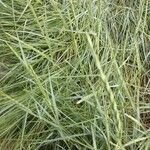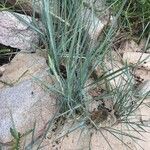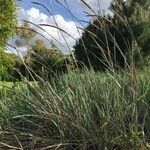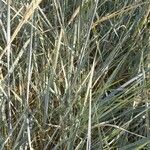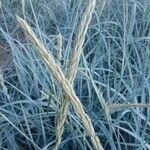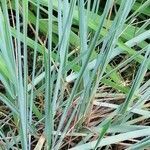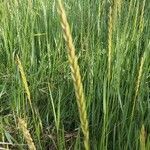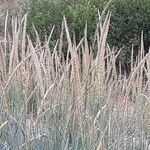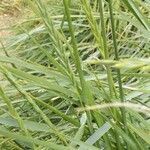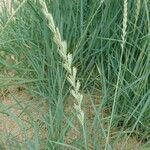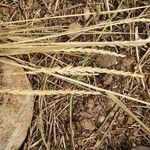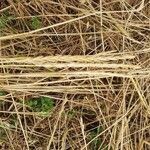Green-or blue-grey perennials, in thick tufts 60-140 cm, with long, strong rhizomes. Leaf-sheath glabrous, firmly chartaceous, shredding into fibres at maturity, cream to light brown, with chartaceous auricles to 3 mm. Ligule 0.6-1 mm, rim-like, obviously ciliate. Leaf-blade 12-75 cm × 6-12 mm, flat or involute, rigid, abaxially smooth, adaxially finely scabrid on ribs, long-narrowed to pungent tip. Culm 45-110 cm, erect or spreading, internodes glabrous. Spike 14-30 × 1.5-2 cm, stiff, erect, with paired spikelets appressed to rachis; rachis angled, margin finely hairy or glabrous. Spikelets 16-25 mm, 3-6-flowered, yellowish green. Glumes equal, ≈ spikelet, 3-5-nerved, narrow-lanceolate, rigid, abaxially with scattered fine hairs, especially on keel and towards margins near acuminate or mucronate tip, adaxially finely hairy. Lemma 13-20 mm in lower florets, upper lemmas shorter, 7-nerved, lanceolate, acuminate to mucronate, firm, abundantly silky-pubescent throughout. Palea ≈ lemma, folded, keels finely toothed, interkeel minutely silky-pubescent near apex, membranous margins of flanks contiguous, conspicuously short hairy; adaxially hairy, shortly ciliate at notched apex. Callus 0.5 mm, bearded with long hairs. Rachilla 3.5-4 mm, abundantly silky-pubescent. Lodicules 2.5-2.75 mm, ciliate. Anthers 6-7.2 mm. Gynoecium: ovary 1.5-2 mm, orange-brown, hair covered; stigma-styles 2.8-3.5 mm. Caryopsis 7-9 × 2-2.5 mm.
More
Strongly rhizomatous. Culms 50–180 cm high. Leaves usually with falcate auricles to 2.3 mm long (sometimes rounded and indistinct); ligule 0.5–1 mm long, firmly membranous, apically shortly ciliate; blade 20–60 cm long, 8–18 mm wide, glabrous, adaxially scabrous, bluish. Spikes 15–25 cm long, with 15–28 pairs of spikelets; peduncle ciliate along margins and often pubescent just below nodes. Spikelets sessile, 18–30 mm long. Glumes equal, as long as spikelet or slightly shorter, narrowly lanceolate, coriaceous, keeled, 3–5-nerved. Callus c. 0.5 mm long, rounded, thickened, pubescent. Basal lemma lanceolate, 15–25 mm long, narrowly tapered or minutely awned by excurrent midrib, similar in firmness or slightly thinner than glumes, keeled at least toward apex, (5–) 7-nerved, densely hirsute to subvelutinous. Palea with 2 sometimes unevenly scabrous-ciliate keels. Anthers 6–8 mm long.
Much like no. 2 [Leymus mollis (Trin.) Pilg.] but more glaucous and less hairy, the culms glabrous or nearly so even at the summit, the glumes stiffer, glabrous or inconspicuously hairy; 2n=56. Native of n. and w. Europe, locally intr. about the Great Lakes. (Elymus a.)
A vigourous grass with spreading rhizomes. It grows 30-38 cm high and spreads 0.9-2 m wide. The leaves are silvery and arch over. They are 60 cm long. The flowers are white and in upright spikes.
